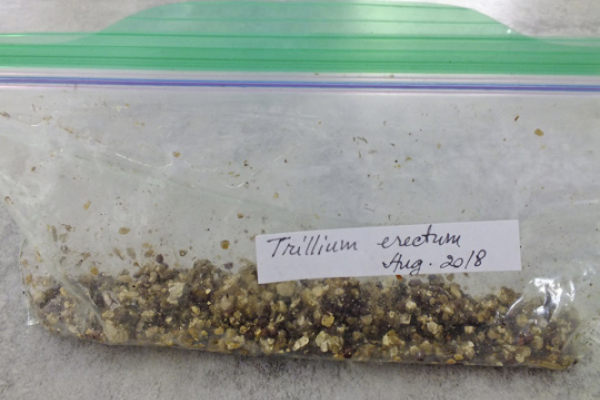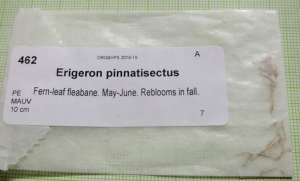REVIEWING THE DONATIONS to our recent seed ORG&HPS (Ontario Rock Garden & Hardy Plant Society) exchange brought to mind the problem of non-viable seed. It’s disappointing when the seeds you ordered don’t germinate. What might have gone wrong?
Hydrophilic seeds will not survive desiccation
Some seeds have a high moisture content. If they lose much of this moisture, the embryo inside will die. Even when stored at optimal temperatures, they quickly lose viability. This group is classified as “recalcitrant” (Eric H. Roberts, 1973); Bill Cullina of the New England Wildflower Society introduced the term “hydrophilic” to describe them. Gabriela Costea, who owns BotanyCa, uses the latter term. “Recalcitrant” suggests “obstinate.” In fact, these seeds are anything but obstinate. Their embryos are raring to go.
In the past, many gardeners referred to these seeds as “ephemeral,” but that term causes confusion. “Ephemeral” is rightly applied to those spring-flowering woodland plants which die back shortly after blooming and disappear until the following year. Some of them produce hydrophilic seeds; others do not.
Success in propagating hydrophilic seeds is straightforward. Collect them as soon as they are ripe, then immediately clean and sow them. If you must store them, put them in sealed plastic bags in slightly moist vermiculite or peat moss. The medium must be just moist, not wet and you need to use a fairly roomy bag. In small bags, the seeds have the tendency to rot, perhaps because they lack oxygen. There is no need to spray the seeds with any chemical. The bags should be kept at the same temperature that the seeds would experience out of doors. Keep them warm during summer, coolish towards the fall and then 40⁰F (4⁰C) at the onset of winter. Do not store them in the freezer because the formation of ice crystals will damage cell membranes.
Many groups are unable to ensure the proper conditions for storage and frigid temperatures encountered during shipment will kill any remaining embryos. The NARGS seed exchange will accept damp-packed hydrophilic seeds from the United States, but not from outside the country. If donating seeds to other exchanges, check to see if they will accept hydrophilic seeds.
Exchanging hydrophilic seeds informally
If you are willing to collect and share hydrophilic seed, you will need to plan ahead. Make it known within your group in advance which specific species you are going to have available. Your offerings could also be posted on Facebook or Instagram.
Those who want to obtain these seeds can then send self-addressed, stamped envelopes, one for each species, to the donor who will ship them as soon as they are ripe. The first of the seeds might be ready early in May, but some species don’t mature until late summer.
Some seeds have a short lifespan
Many genera include species bearing seeds of fairly limited viability. However, not all species in a given genus will necessarily demonstrate this characteristic. If sown after six months, they might germinate but are less likely to produce vigorous plants. Within this category, germination is affected by a wide range of factors like genetics, temperature and moisture conditions under which the seed ripened, the maturity of the seed at harvest and the altitude at which the mother plant grew. Alpines, with their brief growing season and cool conditions for seed maturation, often bear seed that is of shorter viability than the identical species grown at lower elevations.
In addition, some species of aconitum, adonis, delphinium, epimedium, erythronium, and trillium are partially hydrophilic and will tolerate a degree of drying. If you are planning to save them, you might want to provide temporary storage in barely moist vermiculite. Gabriela Costea comments that species with green seed coats at the time of collecting (for example, anemone, erythronium, hepatica, jeffersonia) need to be left for one day or so to dry a bit; if placed in moist medium right away, it’s a sure disaster.
ORG&HPS lists over 8000 different kinds of seed in the Germination Guide of its website www.onrockgarden.com. When your seed order arrives, check the Germination Guide and heed the advice, particularly if it is recommended to sow seeds immediately.
All seed deteriorates over time, especially if improperly stored
After collection, seeds must be dried well and placed in a paper container. Mold can destroy seeds stored in plastic. Glassine envelopes work well for storage. Once seed has been collected, it should be stored in a cool, dry place such as a basement. In his blog, Robert Pavlis, an ORG&HPS member, explains that placing freshly harvest seeds directly into storage in the refrigerator can interfere with maturation of the embryo. His full article on the subject is on the web https://www.gardenmyths.com/storing-collected-seed-fridge-or-freezer.
Your own stash of leftover seed presumably will be very dry if it is not sown within a year. The stash probably will not then be harmed by storage in a freezer or refrigerator. Old seed can be coaxed into germinating by using GA-3 (Gibberellic acid, a plant hormone that encourages germination if used properly).
No matter how carefully you have stored your seed, whether of garden origin or purchased commercially, if it was not collected in the current year, it should not be donated to seed exchanges. Exceptions might be made if the species is particularly valuable. Every seed exchange’s reputation for offering good seed relies on donation of fresh material.
Chaff is not the same as seed
The family asteraceae (commonly known as composite flowers), as well as some others, must be prepared carefully before donation. Many of the fruits are empty and only a few contain viable seeds. Achillea, aster, anaphalis, solidago, and syneilesis are but a few examples of plants whose seed heads are composed primarily of chaff.
Your seed should be thoroughly cleaned before donation. Searching through seed heads and calyces for seed can be quite time-consuming. Seed is the hard, plump material which cannot be crushed between your fingers. Discard any soft, loose fibrous material.
With thousands of packages of seed to prepare, packaging volunteers usually cannot spare the time to go through a pile of chaff looking for viable seed. You should hear the groans when a packer encounters uncleaned seed! In cases where the donation contains a lot of chaff, packers at ORG&HPS are told to put a generous quantity of the questionable material in each package in hopes that there are at least three good seeds in each order. Unfortunately, if the order is being sent to a jurisdiction where the import of uncleaned seed is prohibited, the package might be confiscated.
If you are keeping the seed heads for your own needs, cleaning is not as important. Break apart the seed head and sow the entire contents. The few seeds amongst the chaff will likely germinate despite the non-viable material around them.
The following lists can help you decide how to pack your seeds, and which seeds will be accepted by various seed exchanges. These lists are kept up-to-date in a permanent posting on the ORG&HPS website http://www.onrockgarden.com/page/seed-exchange. If you are unsure about a particular plant not on these lists, a search online combining the scientific name of the plant with the word “germination,” “hydrophilic,” or “recalcitrant” will often turn up useful information.
Hydrophilic seeds, accepted, damp packed, by the NARGS seed exchange as long as they are posted from the USA:
Adonis vernalis
Amaryllis
Anemone nemorosa
Anemone quinquefolia
Anemonopsis
Anthurium
Asarum
Caltha palustris
Caulophyllum
Castanea sativa
Claytonia
Clintonia
Clivia
Coptis trifolia
Dicentra
Dysosma
Eomecon chionantha
Hepatica
Hylomecon vernalis
Jeffersonia
Lindera benzoin
Medeola
Maianthemum
Nerine
Paris quadrifolia
Plagiorhegma
Podophyllum
Ranzania
Sanguinaria
Symplocarpus
Stylophorum
Trillium albidum, grandiflorum
Uvularia
Seeds with short viability, which are welcome donations to most seed exchanges:
Acantholimon
Aconitum
Anemone
Astrantia
Callianthemum
Corydalis
Daphne
Delphinium
Epimedium
Eranthis
Erythronium
Fritillaria
Gentiana
Glaucidium
Helleborus
Primula
Pulsatilla
Ranunculus
Saxifraga
Soldanella
Tanacetum
Thalictrum
Tiarella
Trillium chloropetalum, erectum, kurabayashi, rivale
Viola
Zephryanthes


